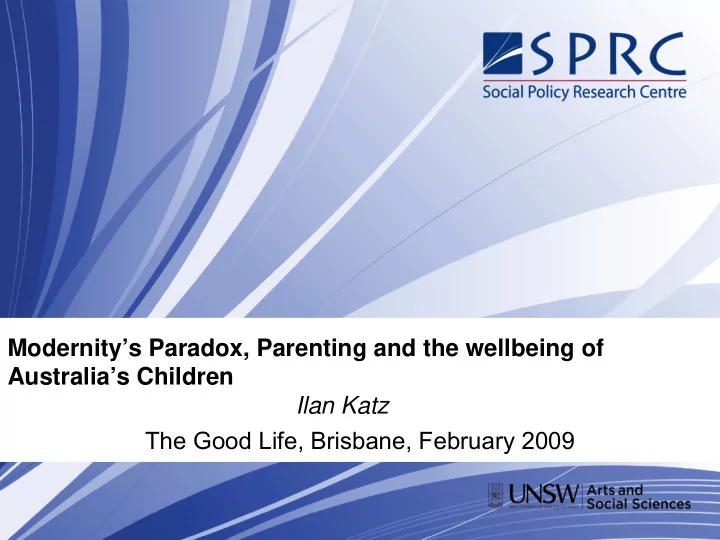

Modernity’s Paradox, Parenting and the wellbeing of Australia’s Children Ilan Katz The Good Life, Brisbane, February 2009
Will cover The debate: is childhood getting worse and why? Who is debating – and why? The child wellbeing indicators movement Is the past a foreign country? Parenting in the past and the present Conclusions; what is the ‘good life’?
THE ARGUMENT
The Debate Growing consensus that ‘childhood’ has deteriorated compared to previous generations. Both ‘left’ and ‘right’ see childhood as tainted. − Left ; unbridled capitalism, advertising, screen violence and individuality − Right; breakdown of traditional families, moral laxness, children’s rights etc. Only libertarians and governments disagree
Basic line of argument ‘Modernity’s Paradox’ leads to ‘toxic childhood’ – we are getting richer but children have lower wellbeing. The basic problem is that society is changing too fast and children are victims of change. Something must be done to stop this decline and get back to our previous good life. One of the main causes is the decline in parenting.
What to do? The answer is better social policy There are relatively simple interventions which would alleviate the problems. We need more data to truly understand what is happening and what to do about it. In particular we need more social capital and less individualism. Other countries do this better, especially Scandinavians.
Responses Growth of the child indicator movement Raft of early intervention and parenting programs Growth of children’s rights movement New policies to support parents and promote fertility – baby bonus, child care tax credit, parental leave etc. Burgeoning book market Affluenza, Toxic Childhood, Good Childhood Report etc
The child wellbeing indicators movement Indicators evolved from: − ‘Deficit ‘ to ‘strengths’ − ‘Becoming’ to ‘Being’ − Objective to subjective − System indicators Huge growth in ‘report cards’ and other measurements of child wellbeing Much better understanding of children’s lives
Problems with child indicators Data driven − Rely on surveys or administrative data which often serves as a proxy rather than direct measure Arbitrary − Always possible to choose indicators which show either improvement or deterioration. Lack of context Often difficult to interpret . − Difficulty with subjective wellbeing which is the main area of concern.
THE EVIDENCE
Compared to the past, children now: Have far more material goods Receive far more interventions from health and welfare organisations Live indoors more and spend more time in structured activities Live in far more diverse family, community and cultural contexts Have lives which are far more fluid and subject to change
Mixed evidence Physical and mental health – in some ways it has improved but in others it has deteriorated. Social and emotional wellbeing − Big increase in diagnosis of ADHD and mental illness but some evidence that things may be improving. Child abuse: − Huge increase in notifications but research shows a long term decline in CSA worldwide
Recollection of CSA by different age cohorts Any CSA event (%), by gender and age cohort Source, Dunne et al (2003) p146
Parenting Three main arguments for deterioration of parenting: 1. Demographic; fewer extended families, more single parents 2. Social; less social capital, more time at work, higher expectations, fewer role models. 3. Lack of information about parenting.
However No direct evidence that parenting has deteriorated Parents spend more, not less, time with their children than previously. Some social and demographic changes favour better parenting: − Older parents, smaller families, less physical chastisement, more involvement in school,
Parents’ time with children Total paid and unpaid work, Men and Women, 1992/2006 Source: Craig and Mullan (2009)
Two conceptions of children Children as seedlings − Need to be nurtured and protected until they can become resilient adults Children as apprentices − Children need to experience and deal with adversity; life can’t be taught.
Constructions of parents Punitive; parents are responsible for their children’s problems Patronising; parents are inadequate and need more expert information and support
Risk Conflict/confusion about freedom and risk − Concern that children are at risk – from muggers, internet stalkers, inappropriate advertising , sexualisation, junk food, computer games etc − But also that children are too constrained – ‘minded out of their minds’, with few opportunities to just be children and play in the streets, walk to school or go on adventures.
Happiness Wellbeing equates with happiness – good relationships, positive experiences and high self esteem − Vs Children need to be able to be sad. Loneliness, anxiety, doubt etc are part of life which must be experienced in childhood. No one-to-one relationship between subjective and objective wellbeing
Whose good life? Perhaps some children’s wellbeing is improving but others deteriorating ‘Health Gradient’ Temperamental differences between children from different SES. However ‘Affluenza’ theory posits that wealth can also cause problems
Are we closer to the good life? ‘Objective’ data shows that children are improving in most dimensions but there are some very concerning trends. No one really understands why, and the superficial consensus hides deep ideological divides. We do not know whether subjective wellbeing has improved for some or all children Nor do we know if parenting is better or worse
Context Construction of a ‘good’ childhood has changed. Parenting has changed – but then the context has changed too. Parents must respond to new context Parents are more anxious and worried – but not sure if this is good or bad for children.
Conclusion We don’t understand the unintended consequences of policies/programs. And it may be that there are trade-offs: − Safety vs autonomy, freedom − Children’s rights vs children’s risks − Parents’ wellbeing vs children’s − Human capital vs happiness (Finland) Task is to learn from mistakes and improve – not to create utopian ‘good life’
Ilan Katz Social Policy Research Centre Ilan.katz@unsw.edu.au www.sprc.unsw.edu.au G2 Western Campus University of New South Wales Kensington 2052 NSW, Australia +61 2 9385 7810
Recommend
More recommend